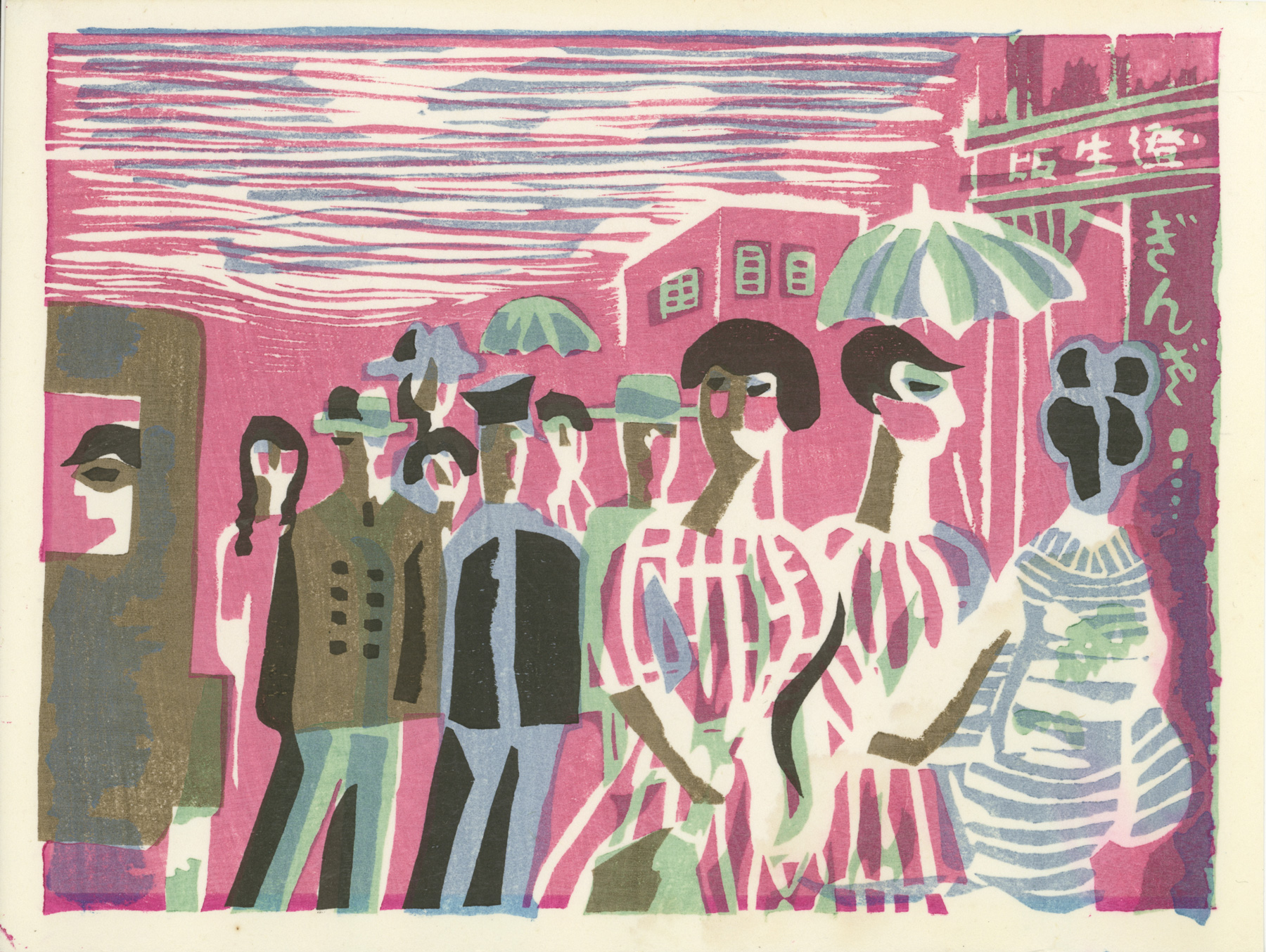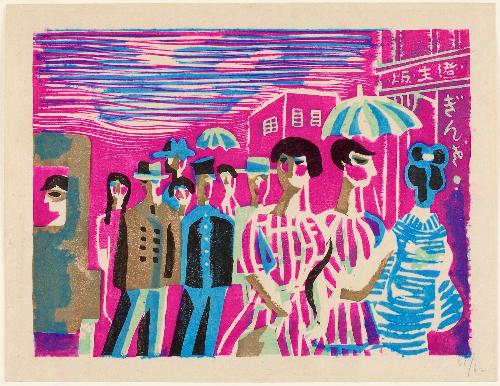About This Print
This print is the 1945 version of Night in Ginza (issued as part of the 15 print series Scenes of Last Tokyo (Tokyo kaiko zue) which was originally issued in 1929 as part of the series One Hundred Views of New Tokyo (Shin Tôkyô hyakkei). (See picture of 1929 version below.) See IHL Cat. 33 to view a recent reissue of the 1929 print and for a more detailed comparison with the 1945 issue.
Source: The Japanese Print Since 1900:Old Dreams and New Visions, Lawrence Smith, British Museum Publications Ltd., 1983 p.87.
This [1945] portfolio of fifteen prints (Scenes of Last Tokyo) expresses an intensenostalgia for the artists' haunts of pre-war Tokyo which had just beendestroyed. Nine leading Sosaku Hanga artists of the Japanese PrintAssociation contributed to it. Kawakami’s view of Ginza in the 1920sis the most memorable and the most lurid.
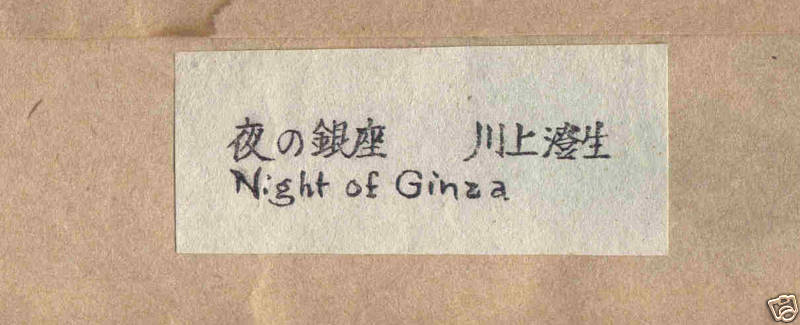
Original 1945 folder label of this print
夜の銀座 川上澄生
1929 Original Issue of Night at Ginza
Number 65 from the series One Hundred Views of New Tokyo (Shin Tôkyô hyakkei)
Ginza (#65), 8/7/1929Carnegie Museum of Art 89.28.1313.2
Modern Boys and Girls on the Ginza
Source: Terrific Tokyo A Panorama in Prints: from the 1860s to the 1930s, Elizabeth de Sabato Swinton, Worcester Art Museum. 1998 p. 76Source: Ukiyo-e to Shin hanga - The Art of JapaneseWoodblock Prints, Amy Newland and Chris Uhlenbeck, Brompton BooksCorporation, 1990 p. 208, 210.
Night in Ginza provides a glimpse at the Japan of the 1920s when Western dress and culture was all the rage, when young women, as seen in the foreground of the print, had bobbed hair just like the flappers in the West. These moden garu (modern girl) strolled down the avenues of the fashionable districts like the Ginza. In this print, these women contrast the kimono-clad woman who oddly enough stands with her back turned towards them.
Ginza 1926 and Today
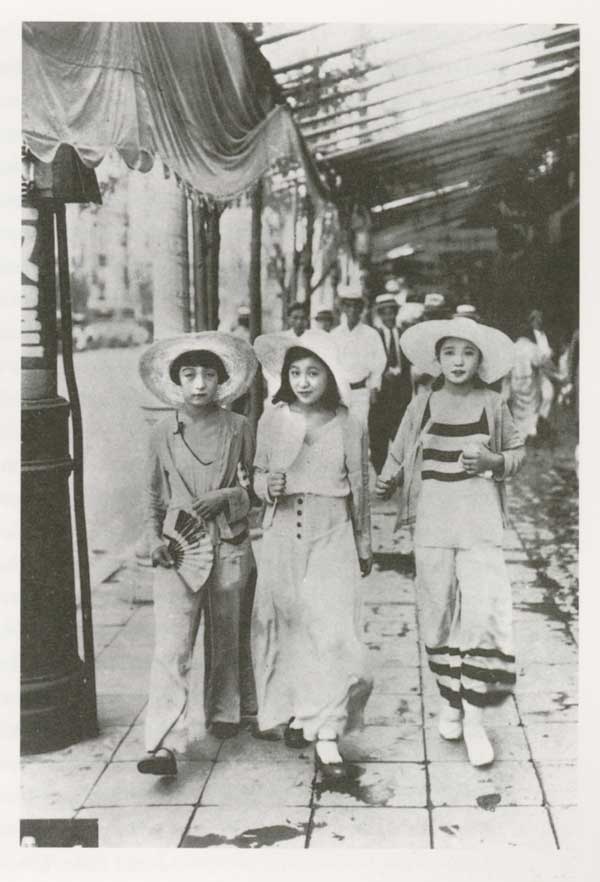 "Modern girls" in beach pajama fashion on the Ginza c. 1926 | 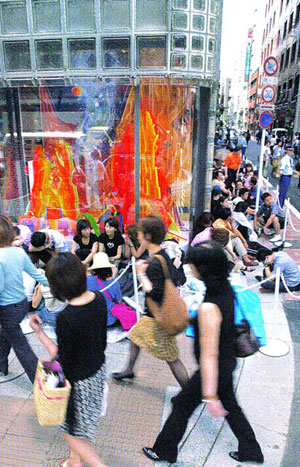 |
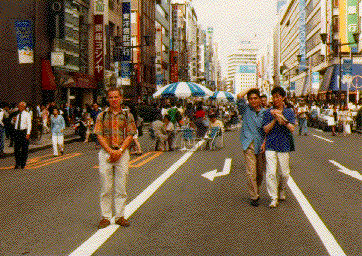
(note the coincidental blue umbrellas which also appear in the print)
Print Details
| IHL Catalog | #253 |
| Title | Night at Ginza 夜の銀座 Yoru no Ginza |
| Series | Scenes of Last Tokyo [also seen translated as Recollections of Tokyo] 東京回顧図会 Tokyo kaiko zue |
| Artist | Sumio Kawakami 川上澄生 (1895-1972) |
| Signature | Sumio han (print by Sumio) in upper right of image disguised as the name of a building |
| Seal | none |
| Publication Date | originally 1929 in the series One Hundred Views of New Tokyo (Shin Tokyo hyakkei). Again in 1945 using recarved blocks for the series Scenes of Lost (Last) Tokyo (Tokyo kaiko zue) |
| Edition | 1945 |
| Publisher | Fugaku Shuppansha 富岳出版社, Tokyo, Uemura Masurō 上村益郎 publisher |
| Printer | Hirai Kōichi 平井孝一 |
| Impression | excellent |
| Colors | excellent |
| Condition | excellent- watermark on back, slightly noticeable on front. Accompanied byoriginal paper label printed with artists' names and titles in bothJapanese and English |
| Genre | sosaku hanga (creative print) |
| Miscellaneous | Reprinted for Tokyo Kaiko zue from recut blocks of 1929 image (see below) which was originally published as part of the series One Hundred Views of New Tokyo (Shin Tokyo hyakkei). Also see catalog #33 for a 1979reprint of the 1929 image. |
| Format | chuban |
| H x W Paper | 7 1/2 x 10 1/4 in. (19 x 26 cm) |
| H x W Image | 7 1/4 x 9 1/2 in. (18.4 x 24.1 cm) |
| Collections This Print | Museumof Fine Arts Boston 59.838; Carnegie Museum of Art 89.28.709.5;Worcester Art Museum, Members’ Council Fund, 1987.79.9; The BritishMuseum 1980,1227,0.18.12; Mead Art Museum at Amherst College 2008.63.12; Smithsonian Freer Gallery of Art and Arthur M. Sackler Gallery S1995.118.4; Portland Art Museum 1996.31.2l; Yokohama Museum of Art 2000-PRJ-002-12 |
| Reference Literature | The Artist's Touch, The Craftsman's Hand: Three Centuries of Japanese Prints from the Portland Art Museum, Maribeth Graybill, Portland Art Museum, Oregon, 2011, p. 301; The Japanese Print Since 1900: Old dreams and new visions, Lawrence Smith, British Museum Publications Ltd, 1983, p. 36, pl 87; TerrificTokyo A Panorama in Prints: from the 1860s to the 1930s, Elizabeth de Sabato Swinton, Worcester ArtMuseum. 1998 p. 76, pl. 46; Made in Japan – The Postwar Creative Print Movement, Alicia Volk, Milwaukee Art Museum, 2005, p. 35; Modern Japanese Prints: The Twentieth Century, Amanda T. Zehnder, Carnegie Museum of Art, 2009, p. 70 |


